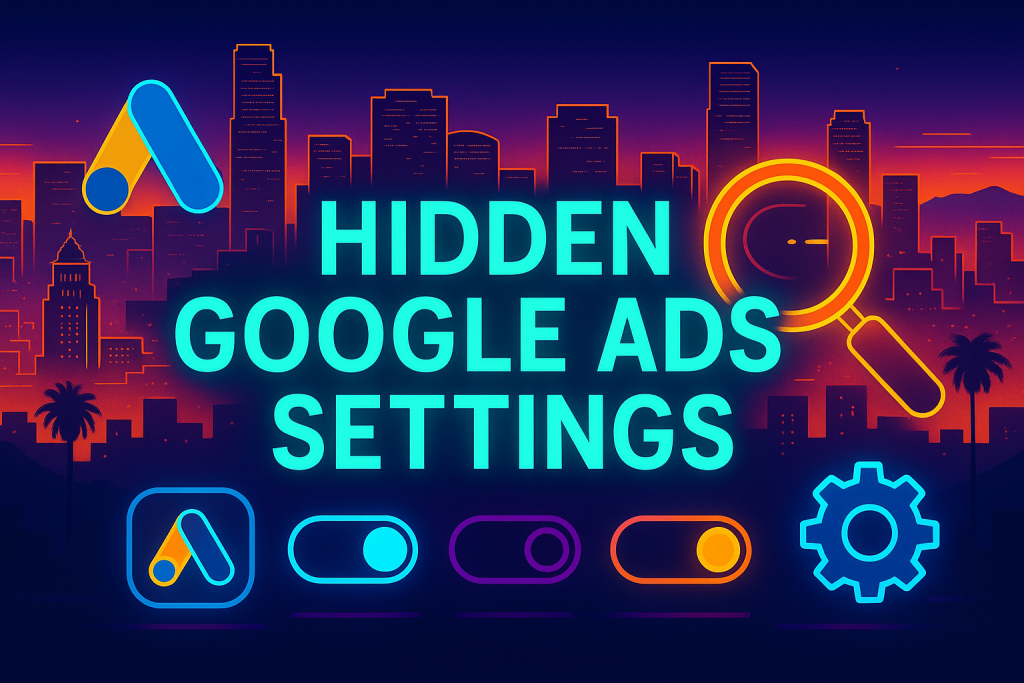
Under‑the‑Radar Tweaks to Supercharge Your LA PPC Performance
You’ve mastered keyword targeting, ad copywriting, and bid strategies—but Google Ads hides powerful controls beneath the surface that most advertisers never touch. These five “invisible” settings have driven our Los Angeles clients to:
- 20–35% higher CTR (vs. account average)
- 15–25% lower CPA
- Up to 30% more conversions
In this in‑depth guide, you’ll get actionable steps, real LA case studies, and proven solutions you can enable in minutes. Pair these tweaks with your Audit Checklist to unlock the next level of performance.
1. Advanced Ad Scheduling (Day‑Parting by Neighborhood)
Why It Matters:
The average Google Ads CTR across industries is just 3.17%—but advertisers who use day‑parting see that jump to 5–7% on peak hours (WordStream, 2024). In Los Angeles, search behavior varies dramatically by ZIP code and time:
- DTLA commuters search “coffee near me” around 7–9 AM
- Santa Monica beachgoers look up “acai bowl” after 3 PM
- Hollywood tourists search “tour buses” midday
Case Study: Beachside Brews
A Santa Monica café implemented two custom ad schedules—6 AM–10 AM for ZIPs 90401/90402 and 3 PM–6 PM for 90404. Within four weeks they saw:
- +28% CTR during scheduled windows
- −18% CPA on those hours
- +22% incremental foot traffic (tracked via promo code usage)
How to Set It Up:
- Campaign → Settings → Ad schedule → “+ Custom schedule.”
- Create multiple schedules per campaign:
- 7 AM–10 AM for 90012, 90014 (DTLA)
- 4 PM–7 PM for 90401, 90402 (Santa Monica)
- Layer bid modifiers: +20% on mobile during evening beach hours, +25% at sunset.
Pro Tip: Pair device bid adjustments with your day‑parting. Evening beach searches skew 75% mobile—boost mobile bids by 30% to capture that traffic.
2. Precision Location Exclusions
Why It Matters:
Up to 15% of traffic in broad campaigns comes from areas with zero conversions—wasting budget. By excluding low‑value zones, you focus spend where it counts.
Case Study: Pacific Yoga Loft
An urban yoga studio saw many clicks coming from USC-area ZIP 90007 that never converted. After excluding 90007 and a 3‑mile radius around LAX:
- −40% wasted clicks
- +12% overall conversion rate
- Budget savings redeployed into high‑ROI neighborhoods (West Hollywood, Santa Monica)
How to Set It Up:
- Tools & Settings → Shared library → Location exclusions → “+ Create.”
- Exclude ZIP codes: 90007, 90089 (industrial), 90210 (too high CPC for casual classes).
- Draw radius exclusions: 3–5 mile circles around airports, event venues, or competitor HQs.
Quote: “Cutting out non‑converting areas was like turning on a faucet of qualified leads.” — Pacific Yoga Loft Marketing Lead
3. Ad Rotation: Rotate Indefinitely vs. Optimize
Why It Matters:
Google’s default “Optimize for clicks/conversions” can prematurely kill under‑tested ads. By rotating indefinitely, you give every variation its fair share of impressions—essential for reliable A/B testing.
- Advertisers using “Rotate indefinitely” for 2–4 weeks saw up to 30% clearer winners before optimization (Google Internal Data, 2024).
How to Set It Up:
- Campaign Settings → Additional settings → Ad rotation.
- Select “Rotate indefinitely” during your testing window (2–4 weeks).
- After each ad has ≥500 impressions, switch back to “Optimize” to let Google’s ML maximize performance.
Solution Tip: Use ChatGPT to generate 5–10 headline variations quickly. Prompt:
“Create five Google Ads headlines promoting an LA plumbing service, emphasizing emergency response.”
4. Shared Negative Keyword Lists
Why It Matters:
Without shared negatives, each campaign drifts into its own wasteful queries. Centralizing them stops irrelevant traffic at the account level.
- Common negatives: “free,” “jobs,” “DIY,” “cheap,” “near me” (for service‑based searches you want serious inquiries).
How to Set It Up:
- Tools & Settings → Shared library → Negative keyword lists → “+ Create.”
- Build themed lists (e.g., “budget shoppers,” “employment seekers”).
- Apply to all existing and new campaigns—review monthly.
Case Study: LA Legal Advisors
A law firm reduced non‑lead traffic by 35% and cut CPA by 22% after applying a shared negative list targeting “jobs,” “internship,” and “free consultation” queries.
Automation Tip: Leverage an Ads script or Zapier integration to parse your Search Terms report weekly and auto‑add new negatives to your shared list.
5. Seasonality Adjustments in Smart Bidding
Why It Matters:
Google’s Smart Bidding can pre‑adjust targets around known peaks—but only if you tell it when. Missed seasonality means lost opportunities in high‑demand windows.
Local Events to Leverage:
- LA Marathon (mid‑March)
- Santa Monica Film Festival (November)
- Echo Park Craft Fair (May)
How to Set It Up:
- Tools & Settings → Bidding → Seasonality adjustments → “+ Custom adjustment.”
- Add each event with:
- Dates: 3–7 day windows
- Expected uplift: +20–50% based on historical data
- Monitor performance and adjust your uplift % quarterly.
Case Study: A local bike rental company saw conversions jump 38% during the LA Marathon week after applying a +40% seasonality bid.
Bonus: AI‑Assisted Automation
Use AI to streamline these five settings:
- Prompt Examples:
- “List top 10 LA ZIP codes by search volume for ‘emergency AC repair.’”
- “Suggest five negative keywords for a high-end Santa Monica spa.”
- Tools: ChatGPT, Bard for drafting; Google Ads Scripts or the Ads API for bulk updates.
- Workflow:
- Generate lists with AI.
- Review and upload via shared libraries or scripts.
- Schedule quarterly AI‑driven audits.
Tracking & Next Steps
- GA4 Custom Channel: Use
utm_source=chat_aion your FAQ links to capture AI‑driven clicks. - Rank Tracking: Employ AEO‑focused tools (SEMrush AI Insights, Ahrefs Questions) to monitor “featured answer” placements for your prompt‑style headings.
- Audit Integration: Feed all metrics back into your Google Ads Audit Checklist every quarter to spot new optimization opportunities.
Conclusion
These five hidden Google Ads settings are quick wins that deliver measurable lifts in CTR, conversions, and cost efficiency. Activate them today, integrate with your full audit process, and watch your Los Angeles campaigns outperform the competition.

